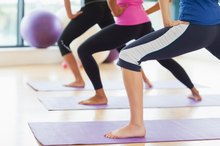What does fact checked mean?
At Healthfully, we strive to deliver objective content that is accurate and up-to-date. Our team periodically reviews articles in order to ensure content quality. The sources cited below consist of evidence from peer-reviewed journals, prominent medical organizations, academic associations, and government data.
The information contained on this site is for informational purposes only, and should not be used as a substitute for the advice of a professional health care provider. Please check with the appropriate physician regarding health questions and concerns. Although we strive to deliver accurate and up-to-date information, no guarantee to that effect is made.
Is It Safe to Exercise With Braxton-Hicks?
Many pregnant women seek to maintain a healthy lifestyle and exercise during their pregnancies. While exercise is probably safe for most pregnant women, you should check with your doctor or midwife to make sure it is safe for you to exercise. Different women experience different risk factors for complications during their pregnancies. If it is okay for you to exercise, know that you might experience Braxton-Hicks uterine contractions.
Braxton-Hicks Contractions
Braxton-Hicks contractions are practice contractions that allow your uterus to exercise and remain strong and powerful for the work of labor at the end of your pregnancy. According to Mayo Clinic, Braxton-Hicks contractions typically begin in the second trimester of pregnancy and feel like tightening in your lower abdomen 1. You might notice that your uterus becomes very hard or tight with these contractions. Braxton-Hicks contractions are painless and irregular. If you experience contractions that are painful and regular, seek medical advice.
- Braxton-Hicks contractions are practice contractions that allow your uterus to exercise and remain strong and powerful for the work of labor at the end of your pregnancy.
- You might notice that your uterus becomes very hard or tight with these contractions.
Exercise During Pregnancy
Is It OK to Start Exercising if I'm Six Months Pregnant?
Learn More
Exercise offers a variety of health benefits to you and your growing baby during pregnancy. Exercise helps with mood stabilization and provides a non-pharmacological approach to treating mild depression and anxiety. Exercise also helps you maintain aerobic fitness, which helps with labor. Strength training prepares you to be able to squat for pushing if necessary. You benefit from yoga, as well, which can enhance your flexibility and feeling of well-being.
- Exercise offers a variety of health benefits to you and your growing baby during pregnancy.
- You benefit from yoga, as well, which can enhance your flexibility and feeling of well-being.
Braxton-Hicks Contractions and Exercise
As women progress through pregnancy, they experience Braxton-Hick contractions more often. You may notice a significant increase in the frequency of these practice contractions during exercise. In general, as long as you have a low-risk pregnancy and the Braxton-Hicks contractions are painless, irregular and stop when you stop exercising, they should not have a negative impact on your pregnancy. Make sure you stay hydrated. If the contractions become painful, regular and do not stop when you stop exercising, consult with your physician or midwife.
- As women progress through pregnancy, they experience Braxton-Hick contractions more often.
- In general, as long as you have a low-risk pregnancy and the Braxton-Hicks contractions are painless, irregular and stop when you stop exercising, they should not have a negative impact on your pregnancy.
High-Risk Pregnancies
Exercises to Avoid During the First Trimester of Pregnancy
Learn More
Women with high-risk pregnancies should not participate in any activity that might trigger Braxton-Hicks contractions, including regular exercise. If you are pregnant with multiples, have a history of preterm delivery, have placenta previa or high blood pressure, discuss your daily activities with your healthcare provider. Regular daily activities, such as walking around a large store or cleaning the house, could trigger Braxton-Hicks contractions. If this occurs, lie down, monitor your contractions and notify your healthcare provider.
- Women with high-risk pregnancies should not participate in any activity that might trigger Braxton-Hicks contractions, including regular exercise.
Related Articles
References
Writer Bio
Marcy Reed has been a certified nurse midwife since 2004 and a writer since 2007. She has been published in "Midwifery Today." Reed earned a bachelor's degree in nursing in California and received her midwifery education in Kentucky.









